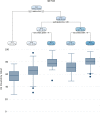Modelling quality of life in children with intellectual disability using regression trees
- PMID: 35322406
- PMCID: PMC9542381
- DOI: 10.1111/dmcn.15206
Modelling quality of life in children with intellectual disability using regression trees
Abstract
Aim: To identify factors associated with quality of life (QoL) in children with intellectual disability. We aimed to identify patterns of association not observable in previous hypothesis-driven regression modelling using the same data set from a cross-sectional observational study.
Method: A questionnaire was completed by 442 caregivers of children with confirmed intellectual disability and a diagnosis of autism spectrum disorder, cerebral palsy, Down syndrome, or Rett syndrome. The Quality of Life Inventory-Disability (QI-Disability) questionnaire was used to assess child QoL. Independent variables described the child's health, functional abilities, community participation, and sociodemographics. The R package rpart was used to build the regression trees.
Results: The mean total QI-Disability score was 69.2 out of a maximum 100. The subgroup with the lowest QoL scores comprised children with a high degree of daytime sleepiness (n=74, mean 57.5) while the subgroup with the highest QoL scores (n=91, mean 80.3) comprised children with little daytime sleepiness who participated more frequently in community activities and displayed good eye contact while listening.
Interpretation: Regression tree analysis provides insights into the relative importance of associated factors. Sleep problems and community participation were more important than functional abilities in accounting for differences in QoL.
What this paper adds: A hypothesis-free regression tree analysis enables examination of multiple factors potentially influencing quality of life (QoL) in children with intellectual disability. Functional abilities were less strongly associated with QoL than sleep problems and community participation.
© 2022 The Authors. Developmental Medicine & Child Neurology published by John Wiley & Sons Ltd on behalf of Mac Keith Press.
Figures



Comment in
-
Quality of life in people with intellectual and developmental disabilities.Dev Med Child Neurol. 2022 Sep;64(9):1056-1057. doi: 10.1111/dmcn.15209. Epub 2022 Mar 18. Dev Med Child Neurol. 2022. PMID: 35304746 Free PMC article.
References
-
- Felce D, Perry J. Quality of life: its definition and measurement. Res Dev Disabil 1995; 16(1): 51–74. - PubMed
-
- Schalock RL. The evolving understanding of the construct of intellectual disability. J Intellect Dev Disabil 2011; 36(4): 223–33. - PubMed
-
- Downs J, Jacoby P, Leonard H, et al. Psychometric properties of the Quality of Life Inventory‐Disability (QI‐Disability) measure. Quality of life research : an international journal of quality of life aspects of treatment, care and rehabilitation 2019; 28(3): 783–94. - PubMed
-
- Williams K, Jacoby P, Whitehouse A, et al. Functioning, participation and quality of life in children with intellectual disability: An observational study. Developmental Medicine and Child Neurology 2021; 63: 89–96. - PubMed
-
- Reddihough D, Leonard H, Jacoby P, et al. Comorbidities and quality of life in children with intellectual disability. Child Care Health Dev 2021; 47(5): 454–66. - PubMed

